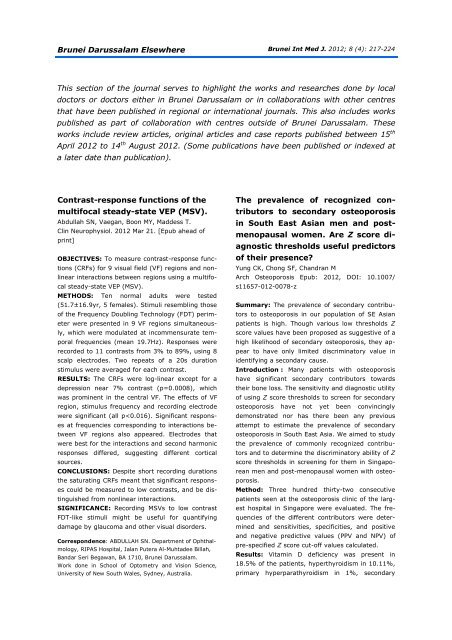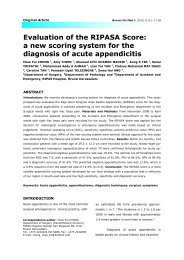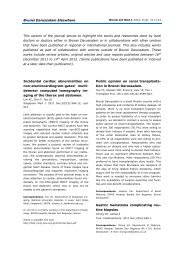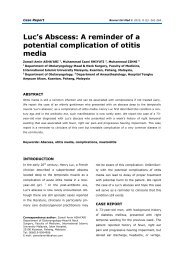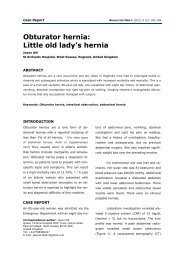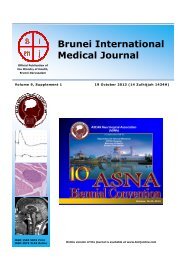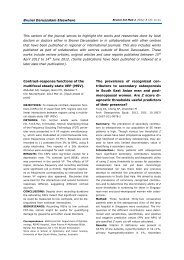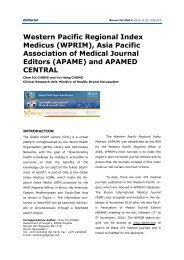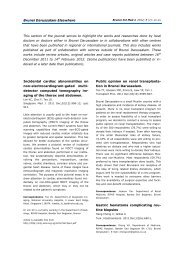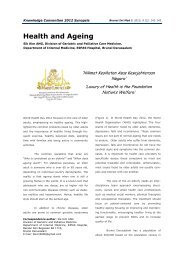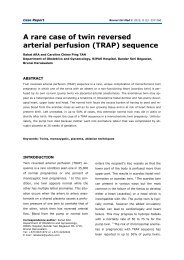BIMJ June 2012 Latest 2 - Brunei International Medical Journal
BIMJ June 2012 Latest 2 - Brunei International Medical Journal
BIMJ June 2012 Latest 2 - Brunei International Medical Journal
Create successful ePaper yourself
Turn your PDF publications into a flip-book with our unique Google optimized e-Paper software.
<strong>Brunei</strong> Darussalam Elsewhere <strong>Brunei</strong> Int Med J. <strong>2012</strong>; 8 (4): 217-224<br />
This section of the journal serves to highlight the works and researches done by local<br />
doctors or doctors either in <strong>Brunei</strong> Darussalam or in collaborations with other centres<br />
that have been published in regional or international journals. This also includes works<br />
published as part of collaboration with centres outside of <strong>Brunei</strong> Darussalam. These<br />
works include review articles, original articles and case reports published between 15 th<br />
April <strong>2012</strong> to 14 th August <strong>2012</strong>. (Some publications have been published or indexed at<br />
a later date than publication).<br />
Contrast-response functions of the<br />
multifocal steady-state VEP (MSV).<br />
Abdullah SN, Vaegan, Boon MY, Maddess T.<br />
Clin Neurophysiol. <strong>2012</strong> Mar 21. [Epub ahead of<br />
print]<br />
OBJECTIVES: To measure contrast-response functions<br />
(CRFs) for 9 visual field (VF) regions and nonlinear<br />
interactions between regions using a multifocal<br />
steady-state VEP (MSV).<br />
METHODS: Ten normal adults were tested<br />
(51.7±16.9yr, 5 females). Stimuli resembling those<br />
of the Frequency Doubling Technology (FDT) perimeter<br />
were presented in 9 VF regions simultaneously,<br />
which were modulated at incommensurate temporal<br />
frequencies (mean 19.7Hz). Responses were<br />
recorded to 11 contrasts from 3% to 89%, using 8<br />
scalp electrodes. Two repeats of a 20s duration<br />
stimulus were averaged for each contrast.<br />
RESULTS: The CRFs were log-linear except for a<br />
depression near 7% contrast (p=0.0008), which<br />
was prominent in the central VF. The effects of VF<br />
region, stimulus frequency and recording electrode<br />
were significant (all p
<strong>Brunei</strong> Int Med J. <strong>2012</strong>; 8 (4): 218<br />
hyperparathyroidism in 6%, hypercalciuria in<br />
21.63%, glucocorticoid use in 8.43%, and hypogonadism<br />
in 9.4% of males. A Z score value of<br />
<strong>Brunei</strong> Int Med J. <strong>2012</strong>; 8 (4): 219<br />
postoperative complications defined as Clavien-<br />
Dindo classification grade II or higher. The yearly<br />
incidence of colectomies for pediatric UC was calculated<br />
and temporal trends were evaluated.<br />
RESULTS: The sensitivity and positive predictive<br />
value of UC and colectomy <strong>International</strong> Classification<br />
of Diseases codes were 96% and 100%, respectively.<br />
The median ages at UC diagnosis and<br />
colectomy were 10.9 and 12.1 years, respectively.<br />
All of the children had pancolitis and 63% underwent<br />
emergent colectomy. Postoperatively, 33%<br />
experienced at least 1 complication. Patients with<br />
emergent colectomy were more likely to have a<br />
postoperative complication compared with patients<br />
with elective colectomy (90% vs 50%; P = 0.03).<br />
For emergent colectomy, postoperative complications<br />
were associated with a disease flare of ≥2<br />
weeks before admission (60% vs 0%; P = 0.03) and<br />
>2 weeks from admission to colectomy (78% vs<br />
22%; P = 0.04). The average annual rate of pediatric<br />
colectomy was 0.059/100,000 person-years and<br />
stable from 1983 to 2009 (P > 0.05).<br />
CONCLUSIONS: Colectomy UC was uncommon<br />
and rates have remained stable. Postcolectomy<br />
complications were common, especially in patients<br />
undergoing emergent colectomy. Optimizing timing<br />
of colectomy may reduce postoperative complications.<br />
Department of Pediatrics, University of Calgary, Calgary,<br />
Canada.<br />
Dr Soon Ing Shian is a Consultant Paediatrician in the<br />
Department of Paediatric, Raja Isteri Pengiran Anak Saleha<br />
Hospital, Bandar Seri Begawan, <strong>Brunei</strong> Darussalam.<br />
Increasing incidence and prevalence<br />
of the inflammatory bowel diseases<br />
with time, based on systematic review.<br />
Molodecky NA, Soon IS, Rabi DM, Ghali WA, Ferris<br />
M, Chernoff G, Benchimol EI, Panaccione R, Ghosh<br />
S, Barkema HW, Kaplan GG. Gastroenterology.<br />
<strong>2012</strong> Jan;142(1):46-54.e42; quiz e30. Epub 2011<br />
Oct 14.<br />
BACKGROUND & AIMS: We conducted a systematic<br />
review to determine changes in the worldwide<br />
incidence and prevalence of ulcerative colitis (UC)<br />
and Crohn's disease (CD) in different regions and<br />
with time.<br />
METHODS: We performed a systematic literature<br />
search of MEDLINE (1950-2010; 8103 citations)<br />
and EMBASE (1980-2010; 4975 citations) to identify<br />
studies that were population based, included data<br />
that could be used to calculate incidence and prevalence,<br />
and reported separate data on UC and/or CD<br />
in full manuscripts (n = 260). We evaluated data<br />
from 167 studies from Europe (1930-2008), 52<br />
studies from Asia and the Middle East (1950-2008),<br />
and 27 studies from North America (1920-2004).<br />
Maps were used to present worldwide differences in<br />
the incidence and prevalence of inflammatory bowel<br />
diseases (IBDs); time trends were determined using<br />
joinpoint regression.<br />
RESULTS: The highest annual incidence of UC was<br />
24.3 per 100,000 person-years in Europe, 6.3 per<br />
100,000 person-years in Asia and the Middle East,<br />
and 19.2 per 100,000 person-years in North America.<br />
The highest annual incidence of CD was 12.7<br />
per 100,000 person-years in Europe, 5.0 personyears<br />
in Asia and the Middle East, and 20.2 per<br />
100,000 person-years in North America. The highest<br />
reported prevalence values for IBD were in Europe<br />
(UC, 505 per 100,000 persons; CD, 322 per<br />
100,000 persons) and North America (UC, 249 per<br />
100,000 persons; CD, 319 per 100,000 persons). In<br />
time-trend analyses, 75% of CD studies and 60% of<br />
UC studies had an increasing incidence of statistical<br />
significance (P < .05).<br />
CONCLUSIONS: Although there are few epidemiologic<br />
data from developing countries, the incidence<br />
and prevalence of IBD are increasing with time and<br />
in different regions around the world, indicating its<br />
emergence as a global disease.<br />
Correspondence: Gilaad G Kaplan, Department of Medicine,<br />
University of Calgary, Alberta, Canada. E mail:<br />
ggkaplan@ucalgary.ca<br />
Dr Soon Ing Shian is a Consultant Paediatrician in the Department<br />
of Paediatric, Raja Isteri Pengiran Anak Saleha<br />
Hospital, Bandar Seri Begawan, <strong>Brunei</strong> Darussalam.<br />
Gastroduodenal intusseception as a<br />
first manifestations of gastric gastrointestinal<br />
stromal tumor.<br />
Basir N, Yaakub AB, Kafeel G, Telisingle PU, Tan KK,<br />
Sharif F, Chong VH. Turk J Gastroenterol. <strong>2012</strong>: 23<br />
(2): 185-6.<br />
Correspondence: VH Chong, Department of Medicine,<br />
RIPAS Hospital, Bandar Seri Begawan BA 1710, <strong>Brunei</strong><br />
Darussalam. Email: chongvuih@yahoo.co.uk<br />
Article is freely available from the journal website at http://<br />
www.turkgastro.org/pdf/1067.pdf
<strong>Brunei</strong> Int Med J. <strong>2012</strong>; 8 (4): 220<br />
Physician home visits by palliative<br />
medicine fellow.<br />
Ang SK, LeGrand SB, Walsh D, Davis MP, Lagman<br />
RL. Am J Hosp Palliat Care. <strong>2012</strong> Mar;29(2):112-5<br />
BACKGROUND: Physician home visits (HVs) are an<br />
important model of care for the terminally ill. Hospice<br />
and palliative medicine (HPM) fellows make a<br />
minimum of 25 HVs.<br />
OBJECTIVE: To describe HPM fellow hospice HVs in<br />
an academic palliative medicine practice.<br />
METHODS: Retrospective chart review of HVs conducted<br />
by 1 HPM fellow.<br />
RESULTS: Twenty-five HVs were made to 21 hospice<br />
patients. Nineteen had advanced cancer. Indications<br />
for visits were symptom management (22)<br />
and education (21). On average 2.8 symptoms (±<br />
SD 1) were addressed on each visit, usually pain.<br />
Medications were reviewed at every visit.<br />
CONCLUSIONS: HVs are an important part for<br />
patient care and fellow education, which provided<br />
an opportunity for medication revision and symptom<br />
education.<br />
evidence to minimize the incidence of such events,<br />
while also suggesting guidelines toward making<br />
their management more effective. A flow chart outlining<br />
management options and strategies to aid the<br />
clinician in the event of such an emergency is also<br />
presented.<br />
Correspondence: Uday Kumar Umesan, National Dental<br />
Centre, Old Airport Road, Berakas, Bandar Seri Begawan<br />
BB3510, <strong>Brunei</strong> Darussalam, Tel +673 8 825021 (mobile),<br />
+673-2-380430 ext 199 (office),<br />
E mail: udayku71@yahoo.com<br />
Article available from the journal website at http://<br />
www.dovepress.com/prevention-and-management-ofaccidental-foreign-body-ingestion-and-asp-peer-reviewedarticle-TCRM<br />
Cerebral abscess with rupture into<br />
the ventricle due to chronic otitis<br />
media.<br />
Bickle I, Mohamed D.<br />
Philipp J Otolaryngol Head and Neck Surg <strong>2012</strong>; 27<br />
(1):35-37.<br />
Correspondence: Ang Sik Kim, Department of Medicine,<br />
RIPAS Hospital, Bandar Seri Begawan , <strong>Brunei</strong> Darussalam.<br />
E mail: Sikim2000@gmail.com<br />
Correspondence: Ian Bickle, Department of Radiology,<br />
RIPAS Hospital, Bandar Seri Begawan , <strong>Brunei</strong> Darussalam.<br />
E mail: ian@bickle.co.uk<br />
Prevention and management of accidental<br />
foreign body ingestion and<br />
aspiration in orthodontic practice.<br />
Umesan UK, Chua KL, Balakrishnan P.<br />
Ther Clin Risk Manag. <strong>2012</strong>;8:245-52. Epub <strong>2012</strong><br />
May 23.<br />
Among the myriad emergencies that could arise in<br />
the dental clinical setting there are a few that occur<br />
occasionally despite being entirely preventable.<br />
Ingestion or aspiration of dental materials, appliances,<br />
or instruments comprises this category. Regardless<br />
of incidence, foreign body ingestion or<br />
aspiration episodes are recognized as potential<br />
complications in the specialty of orthodontics. Despite<br />
their infrequent occurrence, the morbidity<br />
from a single incident and the amount of specialty<br />
medical care that may be needed to manage such<br />
incidents is too high to ignore. There is also the<br />
associated risk of malpractice litigation given the<br />
fact that these incidents are preventable. At present,<br />
no clear guidelines exist regarding prevention<br />
of this emergency in practice. This article attempts<br />
to review relevant literature and aims to formulate<br />
certain recommendations based on best available<br />
Article available from the journal website at http://<br />
www.pso-hns.org/psojournals/pjohns/<strong>2012</strong>a/FROM%<br />
20THE%20VIEWBOX.pdf<br />
Global climate change and its potential<br />
impact on disease transmission<br />
by salinity-tolerant mosquito vectors<br />
in coastal zones.<br />
Ramasamy R, Surendran SN.<br />
Front Physiol. <strong>2012</strong>;3:198. Epub <strong>2012</strong> Jun 19.<br />
Global climate change can potentially increase the<br />
transmission of mosquito vector-borne diseases<br />
such as malaria, lymphatic filariasis, and dengue in<br />
many parts of the world. These predictions are<br />
based on the effects of changing temperature, rainfall,<br />
and humidity on mosquito breeding and survival,<br />
the more rapid development of ingested pathogens<br />
in mosquitoes and the more frequent blood<br />
feeds at moderately higher ambient temperatures.<br />
An expansion of saline and brackish water bodies<br />
(water with 30 ppt salt are termed fresh, brackish, and<br />
saline respectively) will also take place as a result of<br />
global warming causing a rise in sea levels in<br />
coastal zones. Its possible impact on the transmis-
<strong>Brunei</strong> Int Med J. <strong>2012</strong>; 8 (4): 221<br />
sion of mosquito-borne diseases has, however, not<br />
been adequately appreciated. The relevant impacts<br />
of global climate change on the transmission of<br />
mosquito-borne diseases in coastal zones are discussed<br />
with reference to the Ross-McDonald equa–<br />
tion and modeling studies. Evidence is presented to<br />
show that an expansion of brackish water bodies in<br />
coastal zones can increase the densities of salinitytolerant<br />
mosquitoes like Anopheles sundaicus and<br />
Culex sitiens, and lead to the adaptation of fresh<br />
water mosquito vectors like Anopheles culicifacies,<br />
Anopheles stephensi, Aedes aegypti, and Aedes<br />
albopictus to salinity. Rising sea levels may therefore<br />
act synergistically with global climate change<br />
to increase the transmission of mosquito-borne<br />
diseases in coastal zones. Greater attention therefore<br />
needs to be devoted to monitoring disease<br />
incidence and preimaginal development of vector<br />
mosquitoes in artificial and natural coastal brackish/saline<br />
habitats. It is important that national and<br />
international health agencies are aware of the increased<br />
risk of mosquito-borne diseases in coastal<br />
zones and develop preventive and mitigating strategies.<br />
Application of appropriate counter measures<br />
can greatly reduce the potential for increased<br />
coastal transmission of mosquito-borne diseases<br />
consequent to climate change and a rise in sea<br />
levels. It is proposed that the Jaffna peninsula in<br />
Sri Lanka may be a useful case study for the impact<br />
of rising sea levels on mosquito vectors in<br />
tropical coasts.<br />
Correspondence: Ranjan Ramasamy, Institute of Health<br />
Sciences, Universiti <strong>Brunei</strong> Darussalam, Gadong <strong>Brunei</strong><br />
Darussalam. E mail: ranjanramasamy@yahoo.co.uk<br />
Article is freely available from journal website at http://<br />
w w w . f ro n ti e rsi n . o rg/Syst e m s _B i o l o g y / 10. 3 3 89/<br />
fphys.<strong>2012</strong>.00198/abstract<br />
Knowledge of, attitudes toward, and<br />
barriers to participation of colorectal<br />
cancer screening tests in the Asia-<br />
Pacific region: a multicenter study.<br />
Koo JH, Leong RW, Ching J, Yeoh KG, Wu DC, Murdani<br />
A, Cai Q, Chiu HM, Chong VH, Rerknimitr R,<br />
Goh KL, Hilmi I, Byeon JS, Niaz SK, Siddique A, Wu<br />
KC, Matsuda T, Makharia G, Sollano J, Lee SK,<br />
Sung JJ; Asia Pacific Working Group in Colorectal<br />
Cancer.<br />
Gastrointest Endosc. <strong>2012</strong> Jul;76(1):126-35.<br />
BACKGROUND: The rapid increase in the incidence<br />
of colorectal cancer (CRC) in the Asia-Pacific region<br />
in the past decade has resulted in recommendations<br />
to implement mass CRC screening programs. However,<br />
the knowledge of screening and population<br />
screening behaviors between countries is largely<br />
lacking.<br />
OBJECTIVE: This multicenter, international study<br />
investigated the association of screening test participation<br />
with knowledge of, attitudes toward, and<br />
barriers to CRC and screening tests in different cultural<br />
and sociopolitical contexts.<br />
METHODS: Person-to-person interviews by using a<br />
standardized survey instrument were conducted<br />
with subjects from 14 Asia-Pacific countries/regions<br />
to assess the prevailing screening participation<br />
rates, knowledge of and attitudes toward and barriers<br />
to CRC and screening tests, intent to participate,<br />
and cues to action. Independent predictors of the<br />
primary endpoint, screening participation was determined<br />
from subanalyses performed for high-, medium-,<br />
and low-participation countries.<br />
RESULTS: A total of 7915 subjects (49% male,<br />
37.8% aged 50 years and older) were recruited. Of<br />
the respondents aged 50 years and older, 809<br />
(27%) had undergone previous CRC testing; the<br />
Philippines (69%), Australia (48%), and Japan<br />
(38%) had the highest participation rates, whereas<br />
India (1.5%), Malaysia (3%), Indonesia (3%), Pakistan<br />
(7.5%), and <strong>Brunei</strong> (13.7%) had the lowest<br />
rates. Physician recommendation and knowledge of<br />
screening tests were significant predictors of CRC<br />
test uptake. In countries with low-test participation,<br />
lower perceived access barriers and higher perceived<br />
severity were independent predictors of participation.<br />
Respondents from low-participation countries<br />
had the least knowledge of symptoms, risk<br />
factors, and tests and reported the lowest physician<br />
recommendation rates. "Intent to undergo screening"<br />
and "perceived need for screening" was positively<br />
correlated in most countries; however, this<br />
was offset by financial and access barriers.<br />
LIMITATIONS: Ethnic heterogeneity may exist in<br />
each country that was not addressed. In addition,<br />
the participation tests and physician recommendation<br />
recalls were self-reported.<br />
CONCLUSIONS: In the Asia-Pacific region, considerable<br />
differences were evident in the participation<br />
of CRC tests, physician recommendations, and<br />
knowledge of, attitudes toward, and barriers to CRC<br />
screening. Physician recommendation was the uniform<br />
predictor of screening behavior in all countries.<br />
Before implementing mass screening programs,<br />
improving awareness of CRC and promoting the<br />
physicians' role are necessary to increase the<br />
screening participation rates.
<strong>Brunei</strong> Int Med J. <strong>2012</strong>; 8 (4): 222<br />
Correspondence: Ken Koo, Faculty of Medicine, The University<br />
of New South Wales, Sydney, New South Wales,<br />
Australia.<br />
Collaboration work. Chong VH: Department of Medicine,<br />
RIPAS Hospital, Bandar Seri Begawan BA 1710, <strong>Brunei</strong><br />
Darussalam. E mail: chongvuih@yahoo.co.uk<br />
Effect of contrast, stimulus density<br />
and viewing distance on multifocal<br />
steady-state visual evoked potentials<br />
(MSVs).<br />
Abdullah SN, Aldahlawi N, Rosli Y, Vaegan D, Boon<br />
MY, Maddess T.<br />
Invest Ophthalmol Vis Sci. <strong>2012</strong> Jul 10.<br />
Purpose: We investigated the effects of image<br />
contrast, stimulus density, and viewing distance<br />
upon a multifocal steady-state visual evoked potential<br />
(MSV). Methods: Fourteen adults with normal<br />
vision (mean age = 27.0 ± 6.6 yr; 6 males) participated<br />
in the study. Each of the stimulus regions of<br />
the multifocal ensembles presented a contrast<br />
modulated grating displaying spatial and temporal<br />
frequencies that evoke the spatial frequency doubling<br />
illusion. All subjects were tested at 5 contrasts:<br />
0.06, 0.11, 0.22, 0.45 and 0.89; viewed at<br />
16, 32 and 128 cm. A multivariate linear model<br />
estimated factors for each stimulus region, recording<br />
channel, number of stimuli (9- or 17-regions)<br />
and gender; and covariates for contrast, and octaves<br />
of viewing distance and age. Results: The<br />
responses per unit area for the 17-region display<br />
were significantly larger than for the 9-region display<br />
(p
<strong>Brunei</strong> Int Med J. <strong>2012</strong>; 8 (4): 223<br />
the success of a screening colonoscopy program.<br />
Correspondence: Chong VH: Department of Medicine,<br />
RIPAS Hospital, Bandar Seri Begawan BA 1710, <strong>Brunei</strong><br />
Darussalam. E mail: chongvuih@yahoo.co.uk<br />
Article is freely available from the journal website at<br />
http://www.wjgnet.com/1007-9327/pdf/v18/i27/3590.pdf<br />
Comparison of Three Fluid Regimens<br />
for Preloading in Elective Caesarean<br />
Section under Spinal Anaesthesia.<br />
Hasan AB, Mondal MK, Badruddoza NM, Bhowmick<br />
DK, Islam MS, Akhtaruzzaman KM, Islam MM.<br />
Mymensingh Med J. <strong>2012</strong> Jul;21(3):533-40.<br />
The most common problem associated with subarachnoid<br />
block (SAB) for caesarean section remains<br />
the rapid onset of profound hypotension.<br />
This study was designed to compare the incidence<br />
of hypotension after preloading with Ringer's Lactate,<br />
Hydroxyethylstarch and combination prior to<br />
SAB in caesarean section. Ninety non-labouring<br />
ASA grade 1 and 2, aged 20-35 years, weight and<br />
height was 45-60kg and 153-165cm respectively<br />
divided randomly into three groups. Group-RL received<br />
Ringer's Lactate 20ml/kg as preloading fluid.<br />
Group-H received Hydroxyethylstarch-6% 8ml/kg<br />
and Group-RLH received preloading fluid with combination<br />
of Ringer's Lactate 10ml/kg and Hydroxyethylstarch-6%<br />
4ml/kg. Blood pressure (Systolic,<br />
Diastolic & Mean arterial pressure) was measured<br />
every 5 minute for 20 minute and every 10 minutes<br />
thereafter. Hypotension was less in Group-RLH<br />
(6.7%) whereas in Group-H and Group-RL hypotension<br />
was 20% and 47.7% respectively. Systolic<br />
blood pressure decreased significantly in all three<br />
groups. But the decreasing was less in Group-RLH<br />
than other two groups. Less IV fluid was required in<br />
Group-RLH (403ml) and Group-H (577ml) in comparison<br />
to Group-RL (1032ml) to prevent and treat<br />
peroperative hypotension. No ephedrine was needed<br />
in Group-RLH. Variation in Pulse rate was not<br />
significant in Group-RLH (p=0.061). But in other<br />
two groups it was highly significant (Group RL<br />
p≤0.001 and Group H p=0.004). There was no<br />
significant difference in neonatal outcome between<br />
three groups. Preloading with low volume colloid<br />
(4ml/kg) plus crystalloid (10ml/kg) is superior to<br />
crystalloid or colloid alone.<br />
Correspondence: Dr ABM Kamrul Hasan, Staff Anaesthetist,<br />
Department of Anaesthesiology, RIPAS Hospital,<br />
Bandar Seri Begawan, <strong>Brunei</strong> Darussalam;<br />
E mail: drkamrul@gmail.com.<br />
Changes in salivary immunoglobulin<br />
A (IgA) following match-play and<br />
training among English premiership<br />
footballers.<br />
Fredericks S, Fitzgerald L, Shaw G, Holt DW.<br />
Med J Malaysia. <strong>2012</strong> Apr;67(2):155-8.<br />
Decreased salivary immunoglobulin A (sIgA), a<br />
component of mucosal immunity, is associated with<br />
intensive physical activity: suggesting that sIgA<br />
may be used for the monitoring of mucosal immunity<br />
with footballers. We investigated changes in sIgA<br />
in elite footballers, in response to training and<br />
match-play. There was a decrease in sIgA following<br />
training, with a return to pre-training levels after 18<br />
hours of rest. This return to resting levels was not<br />
observed following competitive match-play. Overnight<br />
rest was sufficient for mucosal IgA recovery<br />
following training but not following two successive<br />
matches, suggesting that sIgA may be used to monitor<br />
training in multi-sprint sports.<br />
Correspondence: Fredericks S. PAPRSB Institute of Health<br />
Science, Universiti <strong>Brunei</strong> Darussalam, Jalan Tungku Link,<br />
Bandar Seri Bagawan, BE1410, <strong>Brunei</strong> Darussalam.<br />
E mail: salim.fredericks@ubd.edu.bn<br />
Knowledge of blood transfusion<br />
among nurses.<br />
Hijji B, Parahoo K, Hussein MM, Barr O.<br />
J Clin Nurs. <strong>2012</strong> Jul 25. doi: 10.1111/j.1365-<br />
2702.<strong>2012</strong>.04078.x.<br />
Aims and objectives. To measure nurses'<br />
knowledge of blood transfusion in the United Arab<br />
Emirates. Background. Blood transfusion is a fundamental<br />
aspect of nursing practice and nurses'<br />
knowledge of it is essential for safe practice. Yet<br />
little is known about their blood transfusion practice<br />
and the knowledge that underpins it. The few studies<br />
that have investigated this topic previously have<br />
shown deficiencies in both knowledge and practice.<br />
To date, no such study has been carried out in the<br />
Middle East. Designs. A descriptive, cross-sectional<br />
study. Methods. A random sample of 248 nurses<br />
from two general hospitals in the Emirate of Abu<br />
Dhabi. The response rate was 94AE3%. A<br />
knowledge questionnaire comprising six sections<br />
and 49 items was developed for this study. Data<br />
were analysed using descriptive and inferential statistics.<br />
Results. The overall knowledge scores of<br />
nurses were generally low ranging from 27-56 of a<br />
possible score of 70. Data analysis revealed<br />
knowledge deficits in several key aspects of blood
<strong>Brunei</strong> Int Med J. <strong>2012</strong>; 8 (4): 224<br />
transfusion. There were statistically significant relationship<br />
between nurses' knowledge and the work<br />
setting, the country where they trained and type of<br />
qualifications. Conclusion. This survey highlighted<br />
knowledge deficits which could be detrimental to<br />
patient safety. These results have implications for<br />
nursing education, policy and practice. Relevance<br />
to clinical practice. Nurses have the responsibility<br />
to update their knowledge of and skills in carrying<br />
out blood transfusion. The tool developed in this<br />
study may be useful for educators and managers to<br />
identify gaps in knowledge and inform decisions to<br />
address them.<br />
Correspondence: Belal Hijji, Faculty of Nursing, University<br />
of Ha'il, Ha'il, Saudi Arabia. E mail: bhijji1@gmail.com<br />
Mohammad Moshaddeque Hussein, Institute of Medicine,<br />
Universiti <strong>Brunei</strong> Darussalam, Bandar Seri Begawan,<br />
<strong>Brunei</strong> Darussalam.<br />
Mucormycosis--a possible trigger<br />
pathogen for encapsulating peritoneal<br />
sclerosis.<br />
Tan J, Manickam R, Pisharam J, Telisinghe P, Chong<br />
VH. Perit Dial Int. <strong>2012</strong> Jul;32(4):479-81.<br />
Laryngeal impaction of an archwire<br />
segment after accidental ingestion<br />
during orthodontic adjustment.<br />
Umesan UK, Ahmad W, Balakrishnan P. Am J Orthod<br />
Dentofacial Orthop. <strong>2012</strong> Aug;142(2):264-8.<br />
Orthodontic archwires or fractured appliances that<br />
are accidentally swallowed can become lodged in<br />
the airway or gastrointestinal tract. Inadvertent<br />
ingestion or aspiration of an appliance or archwire<br />
piece during orthodontic appliance adjustment is a<br />
medical emergency with potentially serious complications,<br />
including possible death from asphyxiation.<br />
This article reports the accidental ingestion of a<br />
piece of orthodontic archwire that became impacted<br />
in the larynx; it was subsequently retrieved. Some<br />
potential complications are discussed, along with<br />
suggested precautions to prevent such mishaps<br />
when using fixed appliances.<br />
Correspondence: Uday Kumar Umesan, National Dental<br />
Centre, Old Airport Road, Berakas, Bandar Seri Begawan<br />
BB3510, <strong>Brunei</strong> Darussalam, Tel +673 8 825021 (mobile),<br />
+673-2-380430 ext 199 (office),<br />
E mail: udayku71@yahoo.com<br />
Correspondence: Jackson TAN, Department of Renal<br />
Medicine, RIPAS Hospital, Bandar Seri Begawan, <strong>Brunei</strong><br />
Darussalam. E mail: drjacksontan@yahoo.co.uk<br />
Forthcoming issue of the <strong>BIMJ</strong> (October <strong>2012</strong>) includes<br />
Original Articles:<br />
Uterine sarcoma: Experience of RIPAS Hospital over a 10-year period<br />
Adrenal cell carcinoma: Experience of Universiti Kebangsaan Malaysia<br />
<strong>Medical</strong> Centre<br />
Prevalence of polycystic ovarian syndrome among women of reproductive age<br />
in the Buraimi Region of Oman


